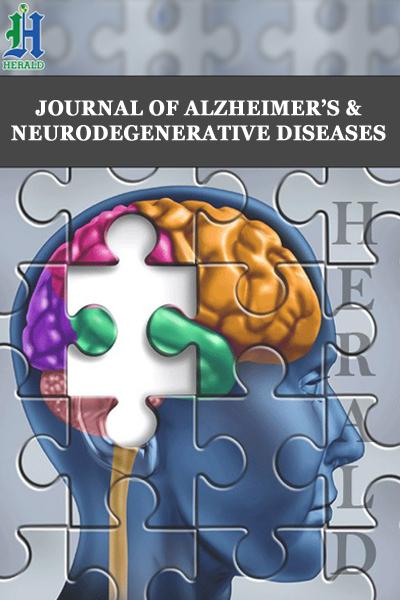
CWPT(Color Words Pick-Out Test) Available for Classifying the Slight Disorder on the Preclinical Stage of Dementia
*Corresponding Author(s):
Takaki ShimuraBme Research Lab, Sosei Ltd., Japan
Tel:+81-53-525-8804,
Email:tshimura@tuba.ocn.ne.jp
Abstract
Objective: Before concept of mild cognitive impairment(MCI) and preclinical stage of dementia(PCSD) our study started to detect slight declines in the brain. The purpose of this study is to clarify the basis of the ability of the devised CWPT (Color Word Pick-out Test) to detect slight disorder and classify it at the MCI and PCSD.
Methods:CWPT is an application of Stroop effect and is including an examination of episodic memory to obtain the evidence and?activation of the prefrontal lobe using an inferred spectroscopy, ?criterion-related validity using CWPT,WCST,HCL, FAB and MMSE ?sensitivity and specificity using MMSE and CWPT are examined.
Results:?It is found using a near infrared spectroscopy that CWPT is the most effective test for the brain activation, in comparison with quick repetition of 4-5numbers in order, in reverse order, Kawashima arithmetic drill and KPT(Kana Pick-out Test).?among the histograms obtained from 22 healthy aging people, onlyCWPTandWCST shownormal distributions besides CWPT has good correlation with WCST. ?Sensitivityand specificity are calculated using MMSE as a true condition and CWPT as a predicted condition for 29 subjects with dementia. Sensitivity becomes 0.963 and specificity becomes 1.0 by the cutoff of the average-1.5SD of CWPT.
Conclusion:As a result of these analyses, it has been suggested that CWPT can be used to classify the level of disorder during MCI and the preclinical stage of dementia.
Keywords
CWPT; Neuropsychologicaltest; PCSD; MCI; Slight disorder
BACKGROUND
Before the concept of mild cognitive impairment (MCI) and preclinical stage of dementia (PCSD) were denominated[1] our research started with the aim of creating a screening test for slight disorder of the brain function in healthy people.Humans recognize information obtained by the five senses, collect them in the prefrontal cortex, judge how to act based on it, and act, so it is hypothesized that cognitive decline should be measured in the prefrontal cortex function. At first, the subjects were given some tasks, and tried to measure the activity of the prefrontal area by ECG and NIRS, but both measurement methods are noisy and the measurement time is long, so we came to the conclusion that they were not suitable for mass screening.Then,we have come up with CKPT[2-6] as a neuropsychological test that can be used for mass screening.
INTRODUCTION
In 2011 Sparling indicated the guidelines for diagnosis of Alzheimer's disease (Figure 1). Research on the treatment of dementia was initially targeted at patients with dementia but has not been successful, and a paradigm shift of research has recently occurred to MCI and PCSD levels.Along with this, there is a need for an easy-to-use method that is not expensive and invasive diagnosis such as PET and MRI etc. as a method for diagnosing therapeutic effects.
Devised CKPT is quite suitable for this purpose,because it can be used for mass screening. CKPT consists of two subtests, one is the applied task of Stroop effect[7] and the other is the task of examining short term memory of episodes.The performance of the two tasks seems to reflect the level of prefrontal function.
In this study, we describe the evaluation results of various kinds of evidence required for practical use of CKPT.
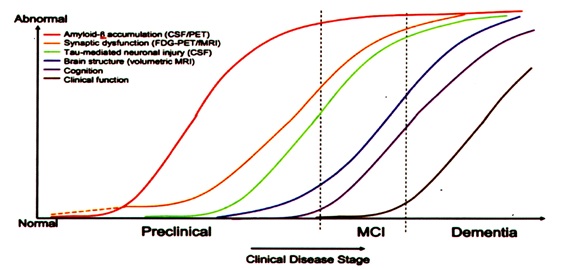 Figure1:Guidelines for diagnosis of Alzheimer's disease.
Figure1:Guidelines for diagnosis of Alzheimer's disease.
METHODS
Actually, the CWPT used in Japan uses Japanese "Hiragana" and "Kanji", it is called CKPT (ColorKanji Pick-up Test). In this paper English version of CWPT isused as a sample which is translated in English.
In CWPT, a story including color words are shown first like Figure2 upside.Subjects should read the story memorizing the episode of itandpick-out color words discerning the matching of meaning and printed color, simultaneously.If the meaning and the printed color of the word are matched, give circle(?) on the word. If unmatched, give cross (×)after that, subjects are required to answer the questions without seeing the story.
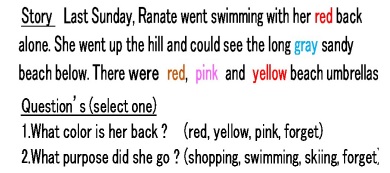 Figure 2:CWPT Upside: Storydown side: Questions.
Figure 2:CWPT Upside: Storydown side: Questions.
The evidences investigated is as follows:
- Activation of the prefrontal lobe using an inferred spectroscopy?
- Criterion-related validity using CWPT, WCST[8], HCL[9], FAB[10]and MMSE[11]
- Sensitivity and specificity using MMSE and CWPT.
ETHICAL CONSIDERATION
For this paper, all subjects have agreed to use the data while keeping their personal information confidential.
EVIDENCES
Evidences investigated are done under a following hypothesis: slight declines in cognitive function should be measured as a decline in the prefrontal cortex, because the prefrontal cortex is a command to wherethat collects information obtained from the five senses and determines human behavior.
Activation of the prefrontal lobe
Subjects: S1:20’s(female), S2:40’s(female), S3: 60’s (female) and S4:80’s(male)
Methods:Activation is examined using NIRS (Near Inferred Spectroscopy), which can obtain real time activation value under doing a task.
Figure 3 shows the principle. Incident near-infrared rays travel scattering in the brain. When the beam backscattered is received out of the skull, the spectrum of the received beam is subtracted from the spectrum of the incident beam and the absorption spectrum on the travelling path is obtained. Using the spectrum, the estimation of the amount of oxy-Hb and deoxy-Hb in the path can be done.
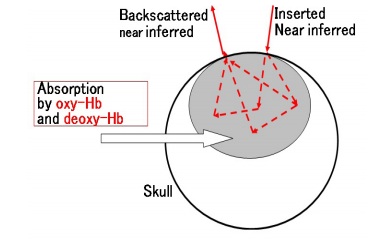 Figure 3: The principle of NIRScomparison is done between tasks under the same volume on NIRS.
Figure 3: The principle of NIRScomparison is done between tasks under the same volume on NIRS.
Result: To compare the activation ability of each task, the average activationvalue is derived from time series signals of each tasks.Table 1 shows the results where relative values for each task are shownina row.To facilitatecomparisonof activation levels, 4 ranks, Low, Moderate, Fair and good are assigned and colored.
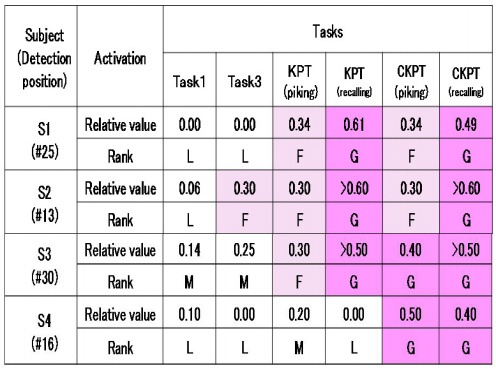 Table 1:Comparison between tasks[12].
Table 1:Comparison between tasks[12].
0.125 < :L, 0.125-0.250: M, 0.250-0.375:F, 0.375>: G
Task1: quick repetition of 4-5 numbers in order
Task3: calculating Kawashima arithmetic drill
KPT: Kana Pick-out Test (picking-out Kana characters and recalling the episode of the story)
CKPT: Japanese version of CWPT(picking-out color words and recalling the episode of the story)
Through this examination, it is found that CKPT is the best task which activates the prefrontal lobe.
Criterion-related validity
Subjects: Numbers: 13mails and 9females, Age: 68.9±4.2, EducationalBG: 2(JuniorHigh School), 10(Senior High School), 5(Junior College), 5(University), Dementia criterion: MMSE>27.
Methods: CKPT, MMSE, WCST: Wisconsin Card Sorting Test, FAB: A Frontal assessment battery at bedside,HCL:HonmaCheckList.
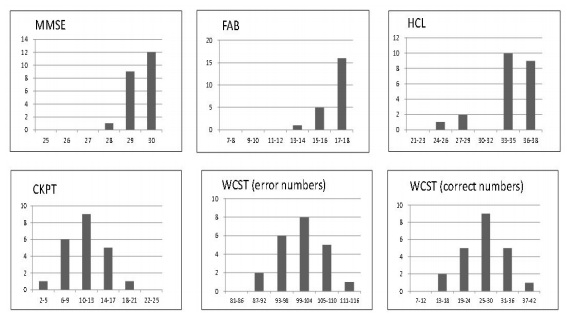 Figure 4: Histograms.
Figure 4: Histograms.
Results:Histograms obtained on each test are shown at Figure 4. On MMSE subjects are distributed
at the right end of the histogram, indicating that they are healthy people. On the FAB histogram, the same tendency is observed. On the other hand, the histogram of HCL has no regularity. The reason is that HCL survey is a form to answer questions. It is an important notice that on CKPT and WCST in the lower part, their histograms have normal distribution and only with this distribution, it is possible to classify functions.
The correlation coefficient between CKPT and other tests are examined and the results are shown at Table2. It is suggested that CKPT correlates with WCST (correct numbers) and WCST(error numbers), which is well known as prefrontal lobe test.
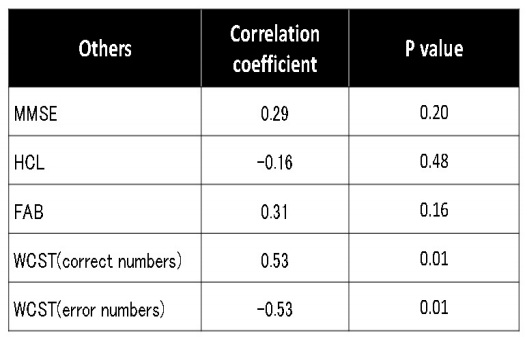 Table 2: Correlation coefficient between CKPT and other tests.
Table 2: Correlation coefficient between CKPT and other tests.
Sensitivity and Specificity
Sensitivity and Specificity of CKPT is examined using MMSE which is used as a general neuropsychological test in the world wide.
Subjects:The subjects are 29 people who attend to day services and have some kinds of dementia (Table3).
 Table 3: Subjects with dementia.
Table 3: Subjects with dementia.
Methods:In order to calculate Sensitivity and Specificity of CWPT, False negative (FN), True negative (TN), False positive (FP) and False positive (FN) are determined first, where true condition is by MMSE using cutoff of 27 points and predicted condition is by CKPT using the cutoff of average-1.5SD (Figure 5). Then sensitivity and specificity are calculated by
Sensitivity = TP/(TP+FN)(1),
Specificity = TN/(TN+FP)(2).
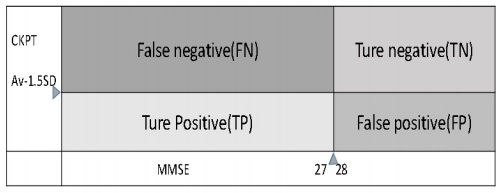 Figure 5: 4 conditions using MMSE and CKPT.
Figure 5: 4 conditions using MMSE and CKPT.
Results: 4 conditions discriminated by average-1.5SD of CKPT is shown for patients with AD (Figure 6). The same analysis are done for the other kinds of dementia, Table 4 is the result.Using the total number, sensitivity and specificity are calculated as 0.963 and 1.0 using Equation 1 and 2, respectively.
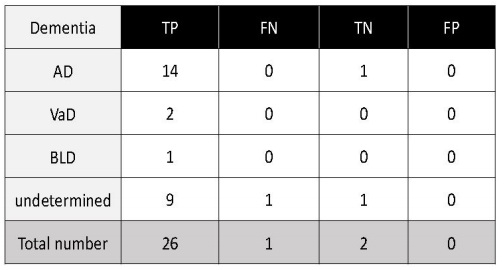 Table 4:Predicted TP,FN,TN,FP of each dementia.
Table 4:Predicted TP,FN,TN,FP of each dementia.
SUMMARY
A neuropsychological test named CWPT (whose Japanese version is CKPT) is developed to classify minor cognitive function impairment before MCI of dementia. It is based on the hypothesis that a minor decline in cognitive function appears in the prefrontal lobe.
In the investigation of evidences, the followingsare pointed out:
• The prefrontal lobe is sufficiently activated during CKPT.
• The histograms of only CKPT and WCST have normal distribution that is the important sign of being able to classify the slight disorder on preclinical stage of dementia.
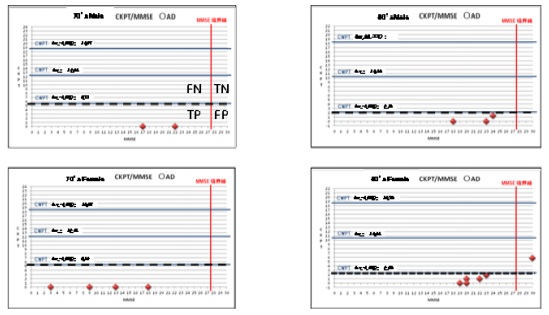 Figure 6:FN, TN, TP, FP of patients with AD.
Figure 6:FN, TN, TP, FP of patients with AD.
• CKPT correlates with WCST which is well known as a prefrontal lobe examination.
• Both sensitivity and specificity are enough.
CONCLUSION
In Japan the number of healthy people who have received CKPT reaches approximately 5000.The criteria used in the process have been derived from the latest patients.Persons with an average value of -1.5 SD or less are advised to receive a specialist doctor. Such operations have been accepted and effective. CKPT is also used to measure the effects of non-drug therapy.
We are hoping to spread CWPT internationally, and are waiting for researchers and entrepreneurs to translate it into the languages of each country and put it to practical use.
ACKNOWLEDGEMENTS
We would like to thank the many people who helped us collect CKPT data. Special attention was given to the people of the Shizuoka Life Support Center, the staff of Fukuroi City and Iwata City, and volunteers. We would also like to thank Satoshi Yamada for helping organize the data.
REFERENCES
- Sperling RA, Aisen PS, Beckett LA, Bennett DA, Craft S, et al. (2011) Toward defining thePreclinical stages of Alzheimer’s disease: Recommendations from the National Institute on Aging-Alzheimer’s Association Working-groups on diagnostic guidelines for Alzheimer’s disease. Alzheimers Dement 7: 280-292.
- Shimura T (2003) Japan Patent No.4887720.
- Shimura T (2004) CN Appln.200480020902.6.
- Shimura T Germany Patent No.1641813.
- Shimura T UK Patent No.1649813.
- Shimura T Korean Patent No.0735647.
- Stroop JR (1935) Studies on interference in serial verbal reactions. Journal of Experimental Psychology 18: 643-662.
- Berg EA (1948) A simple objective technique for measuring flexibility in thinking. J Gen Psychol 39: 15-22.
- Ryan JJ, Paolo AM, Brungardt TM (1990) Standardization of the Wechsler Adult Intelligence Scale Revised for persons 75 years and older. International Journal of Geriatric Psychiatry 11: 149-156.
- Dubois B, Slachevsky A, Litvan I, Pillon B (2000) The FAB: A Frontal Assessment Battery at bedside. Neurology 55: 1621-1626.
- Folstein MF, Folstein SE, McHugh PR (1975) “Mini-mental state”: A practical method for grading the cognitive state of patients for the clinician. J Psychiatr Res 12: 189-198.
- Shimura T (2009) Prefrontal lobe measurement using near infrared spectroscopy-evaluation of early detection methods and rehabilitation methods of dementia 107-118.
Citation: Shimura T, Okuyama E, Osugi H (2019) CWPT (Color Words Pick-Out Test)Available for Classifying the Slight Disorder on the Preclinical Stage of Dementia. J Alzheimers Neurodegener Dis 5: 028.
Copyright: © 2019 Takaki Shimura, et al. This is an open-access article distributed under the terms of the Creative Commons Attribution License, which permits unrestricted use, distribution, and reproduction in any medium, provided the original author and source are credited.
